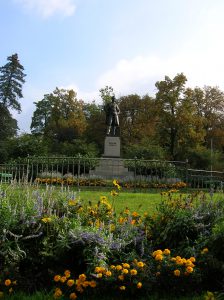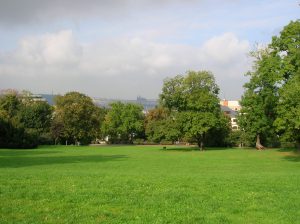Riegerovy Sady Park
By Tracy A. Burns
The park Riegerovy Sady boasts bewitching and breathtaking views of Prague Castle, the Hradčany district, and the Lesser Quarter (Malá Strana). It is situated in Prague’s second district called Vinohrady, a section named after the vineyards that grew there during the Middle Ages. The 11-hectare park is built on former vineyards established during Holy Roman Emperor Charles IV’s reign. Riegerovy Sady consists of a late Classicist observation tower called Mlékárna, which now houses a café; a three-sided obelisk decorated with a relief depicting birds and flowers, and the sporting grounds of Vinohrady’s Sokol, named after a physical education movement that was established in 1862. Also on the grounds are a memorial to 19th-century Czech politician and publicist Frantisek Ladislav Rieger (1818-1903), a playground, and an impressive stone gate. Benches, flowerbeds, trees, and woody plants abound.
Who was František Ladislav Rieger?
 A man who played a significant role in Czech politics for thirty years, the park’s namesake co-founded the National Party, which later was labeled The Old Czech Party. In 1842 he was arrested because the police thought he had been trying to help Polish immigrants. From 1848 to 1849 he was the master of the Czech liberal political movement, along with well-known Czech historian František Palacký. Both protested against the absolutist policy of Austrian politician Klement Wenzel von Metternich during the 1848 revolution. Also a writer, Rieger created the 11-volume Slovník naučný, the first Czech encyclopedia, published from 1860 to 1874. Later, Rieger founded Národní listy, for a long time the most influential newspaper in the Czech lands.
A man who played a significant role in Czech politics for thirty years, the park’s namesake co-founded the National Party, which later was labeled The Old Czech Party. In 1842 he was arrested because the police thought he had been trying to help Polish immigrants. From 1848 to 1849 he was the master of the Czech liberal political movement, along with well-known Czech historian František Palacký. Both protested against the absolutist policy of Austrian politician Klement Wenzel von Metternich during the 1848 revolution. Also a writer, Rieger created the 11-volume Slovník naučný, the first Czech encyclopedia, published from 1860 to 1874. Later, Rieger founded Národní listy, for a long time the most influential newspaper in the Czech lands.
The Statue
Rieger’s statue was forged by sculpture guru Josef Václav Myslbek in 1913. Myslbek, the most renowned sculptor at the end of the 19th and beginning of the 20th century, has many Prague monuments on his impressive curriculum vitae. He created the statues at Vyšehrad and the statue of Saint Václav riding triumphantly on a horse in Wenceslas Square He also helped decorate the interior of the National Theatre and designed sculptural groupings for that theatre’s façade.
The history of the former vineyards
 The history of the former vineyards that are now part of Riegerovy Sady is intriguing, to say the least. The vineyards, destroyed during the Thirty Years’ War, were then replaced by gardens. These included a vegetable garden and a decorative garden adorned with exotic, woody plants. There was even a pond, a maze, and a small zoo. In the early 19th century, a sugar mill stood on the grounds as did a lecture hall for botanical sciences. In 1849 a Czech theatre was constructed there, and well-renowned dramatist Josef Kajetán Tyl graced its stage. A German theatre later took its place. The obelisk in the park dates from 1840.
The history of the former vineyards that are now part of Riegerovy Sady is intriguing, to say the least. The vineyards, destroyed during the Thirty Years’ War, were then replaced by gardens. These included a vegetable garden and a decorative garden adorned with exotic, woody plants. There was even a pond, a maze, and a small zoo. In the early 19th century, a sugar mill stood on the grounds as did a lecture hall for botanical sciences. In 1849 a Czech theatre was constructed there, and well-renowned dramatist Josef Kajetán Tyl graced its stage. A German theatre later took its place. The obelisk in the park dates from 1840.
The creation of Riegrovy Sady
Riegerovy Sady park was created from 1904 to 1908, owned by the municipality. Built-in 1938, the Vinohrady Sokol complex used to be one of the biggest Sokol aerials in the world and was taken over by the SS during World War II. During the war, the name of the park was changed to Smetanovy Sady in honor of famous Czech composer Bedřich Smetana as Rieger was out of favor with the Nazis. In 1947 the park was restored and reverted to its original name.
A restaurant in the park
While in the park, do not hesitate to visit the Park Café, which includes a big summer garden area with room for 1,300 people. Concerts take place there, and sporting events are projected on a big screen. Live music is another plus. The restaurant offers various kinds of pasta and chicken, for example.
Whether you want to become entranced by spellbinding views of Prague, sit on a bench and read or take a walk surrounded by colorful flowers and woody plants, Riegerovy Sady is a superb alternative to a day of hectic sightseeing and seems a world away from nearby Wenceslas Square.



